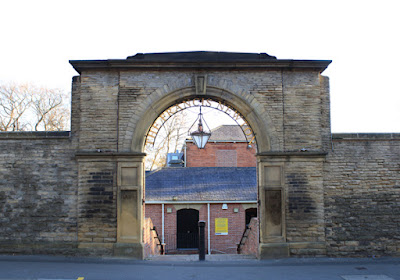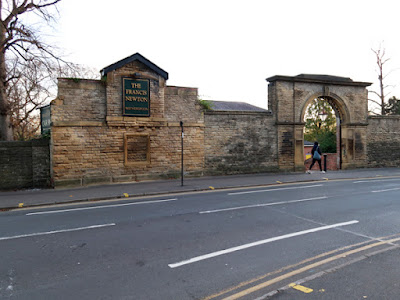 |
| No. 32 Collegiate Crescent |
After briefly looking at the stonework at Sheffield Botanical Gardens, I continued along Clarkehouse Road to Newbould Lane, where the next building on my list to photograph for the British Listed Buildings website was the Grade II Listed former Trinity Congregational Church (1870), which is now used as a gymnasium by the Sheffield High School for Girls.
 |
| The former Trinity Congregational Church |
Returning to Clarkehouse Road to photograph the brick built Nos. 61-67 (c1850) and then the stuccoed Broomgrove House (c1830), I noticed that the front garden of No. 4 Broomgrove Road was being excavated to create a parking area. Having discovered from the workers that sandstone had not been reached, I took a few photos of the exposed section of the Pennine Lower Coal Measures Formation mudstone.
 |
| An excavation in the front garden of No. 4 Broomgrove Road |
Continuing along Clarkehouse Road, which forms the northern boundary of the Broomhall Conservation Area, I turned right onto Park Lane and headed down into the Broomhall Estate, which I had first visited 6 months earlier when investigating the Hunters Bar and Pomona Street Board Schools.
Diverting to Park Crescent to photograph the stuccoed Hyde Place and the brick built Hyde Park Villas, both dated c1860, I continued down Park Lane and briefly stopped at one of the former lodges to this once very exclusive development by the property speculator John Watson.
I didn’t stop to closely examine it but, as during my previous brief exploration of the southern half of the estate, I immediately recognised it as Greenmoor Rock from Brincliffe Edge – with its distinctive flaggy nature setting it aside from the other principal sandstone formations that I had by now got to know on the west side of Sheffield.
Most of the buildings and boundary walls that I had passed since leaving Sheffield Botanical Gardens are built in similar massive sandstones to those that I had seen while exploring Broomhill and Endcliffe Conservation Areas; however, in the parts of the Broomhall Estate that are nearest to Ecclesall Road, Greenmoor Rock has been much more widely used for the garden walls.
Turning on to Collegiate Crescent, I then took a quick look at six moderately sized detached villas, No. 30 and the Grade II Listed Nos. 32-40, which were all built c1860 on generous plots that were landscaped and connected by a drive to a grand sweeping road lined with trees.These are all now occupied by various departments of the Sheffield Hallam University Collegiate Campus and I didn’t see any of the stonework close up. From my photos it looks like local rock-faced, often iron stained sandstone has been used for the walling, with medium grained, uniformly buff coloured Derbyshire gritstone for the dressings.
The next listed structure on my list to photograph was the wall and gatepiers to the Sheffield Hallam University Main Building (c1836), where a very coarse gritstone – probably Chatsworth Grit – has been used for the piers with a similar grey/orange gritty sandstone used for the walling.
Making my way down to Ecclesall Road and then to the bottom of Broomgrove Road, the last building on my list was No. 13 Broomgrove Road, a large house Classical style house built in the early C19, but which is now the offices of Hadfield Cawkfield Davidson – the architectural practice founded in 1834 by the renowned Sheffield architect Matthew Ellison Hadfield.
Having managed to photograph 28 of the 30 listed buildings that I had encountered since alighting from the bus on Glossop Road a few hours earlier, I headed up to Clarkehouse Lane, stopping to look at the Liesegang rings in the sandstone used for the King Edward’s Swimming Pool.
Although not on my list of buildings to photograph, my last stop was at the wall in front of the Francis Newton public house, which now occupies Broombank House, built in the 1820’s for the wealthy cutlery manufacturer, Francis Newton. It is built with blocks of what is probably Crawshaw Sandstone, with a more massive light brown sandstone used for the dressings.
Arriving back at Glossop Road, it had been my intention to catch the very regular No. 120 bus from here back to Sheffield but, having just seen one pull away, I decided to get a bit more exercise in the afternoon sunshine and walked back into Sheffield city centre.










No comments:
Post a Comment